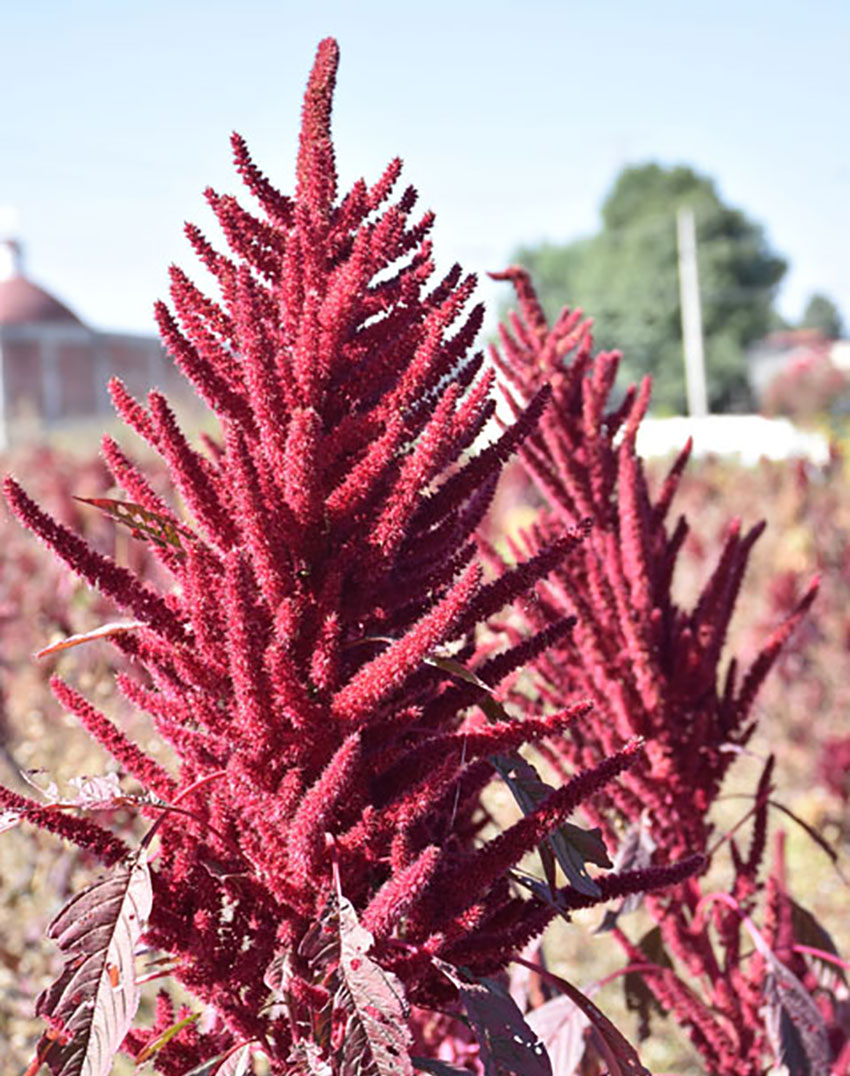Alejo Ávila Camacho surveyed his field of amaranth plants, now turned a bright red and ready for harvesting.
“Tulyehualco,” he said, “is the place for amaranth.” Its complete name is Santiago Tulyehualco, one of 16 pueblos that make up the borough of Xochimilco, located in the southern part of Mexico City, and it’s known as a center for amaranth cultivation.
Ávila estimates that 200 people in the pueblo grow it. “We have planted here since our ancestors,” he continued. “Every pueblo has its own traditions, customs. Here, it is amaranth.”
Amaranth is one of the few plant species whose leaves and seeds can both be eaten. Its leaves are a good source of beta carotene, proteins and ascorbic acid and are also high in calcium and iron and can be eaten raw, in salads, or cooked. The seeds, which are toasted prior to eating, are high in protein, fiber and antioxidants and are a good source of calcium and a number of other minerals.
This has led to its promotion as a superfood in Mexico, where it has a long history. But that history almost ended after the Spanish Conquest.

Mayans first cultivated amaranth, which is actually a group of about 60 species, in the state of Oaxaca between 8,000 and 10,000 years ago and it was a critical part of the indigenous diet, along with corn and beans. In addition to being an important food source, many indigenous cultures in Mesoamerica considered amaranth to be a divine plant and it had a major role in religious ceremonies.
Aztecs used amaranth seeds to create idols representing their gods and, during ceremonies, these idols were eaten. This proved to be a serious problem for the Spanish who found it blasphemous because it was too similar to the Catholic Church’s ritual of communion. And so they prohibited the plant’s cultivation.
Another possible reason for the prohibition was that the idols were red and it was thought that the color came from mixing the seeds with the blood of sacrificial victims, something that would further upset the Spanish.
There are differing opinions about that in Tulyehualco. “Our ancestors, our grandparents, said that the Mexicas used to mix amaranth with blood to make their idols,” said Ávila. “Our ancestors saw this.”
But Camilo Morales Granadas, one of the owners of Sabor de Amaranto in Tulyehualco, doesn’t agree. “Mexicas mixed amaranth with a red tuna (the fruit of the nopal cactus) that produces a very intense red. We know this because we in the pueblo have this knowledge.”
There’s no definitive proof either way.

The Spanish may have also banned amaranth because of its important role in indigenous diets and because it was eaten by Aztec warriors before battle. Depriving people of it could weaken a population. Whatever the reason, fields of amaranth were burned, its cultivation was banned and anyone caught growing it risked having their hands chopped off or losing their life.
Amaranth survived because it was grown clandestinely in parts of what had been the Aztec empire and by the Mayans in the mountains of Oaxaca. Tulyehualco’s residents have benefited from its survival.
Amaranth is harvested in late December in Tulyehualco and during that time, Ávila’s days start in the early morning. “It must be cut when it is not so hot,” he said. “When it is hot, the seeds will fall out when you cut.” He uses a small sickle to cut the stalks using a quick upward motion, then places them in small piles on the ground where they’ll dry in a week or so. The dried stalks are shaken over a canvas to release the seeds, which are then toasted and made into a variety of products.
The Féria de Amaranto — the Amaranth Fair — has been held in Tulyehualco since 1971 but was canceled this year because of the pandemic; with luck, it should return next year. The fair’s a great place to sample all the different ways amaranth is used, and although that wasn’t possible this year, stores are still open and offering a wide selection of products.
Diana Concepción Bravo has been selling amaranth products for 45 years. “Alegría is probably the most popular item,” she said. “It has nuts, amaranth, cranberries, fruit and honey. Also, obleas, and atunero, which a small, round cookie.” The store is also stocked with several varieties of churritos, tasty amaranth sticks flavored with lime, chile, cheese or nopal.
While most people know about the sweets and snacks made from amaranth, there are also healthier options. “We want people to consume amaranth as a food, as they did before, not just as a sweet,” said Morales Granadas. “We want to use it in part to return to our roots, our culture.”

His business sells amaranth powder (used to make a protein drink), pancake mix, amaranth bars and granolas. It’s even possible to buy hamburgers made from amaranth.
And now there’s another popular way to consume amaranth: beer.
“Amaranth beer is very new. It is an artisanal beer,” said Carlos Arzuvida, the manager of Domingo Santo restaurant, located just off Mexico City’s zócalo. “It’s completely different from other beers. Most beers are heavy; this is light with a dry, sweet and creamy taste.”
His restaurant sells a beer simply called “Amaranto” made by Cervecería Aztlán while Sabor de Amaranto in Tulyehualco sells an amaranth IPA and a brown ale.
Downing a few of these tasty brews often makes a person feel like belting out Cielito Lindo, a popular song written by Quirino Mendoza y Cortés, a native of Tulyehualco.
Joseph Sorrentino is a frequent contributor to Mexico News Daily and lives in San Gregorio, Xochimilco.
